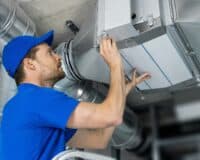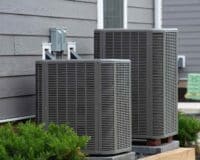If your boiler isn’t working, don’t panic. There could be a number of different reasons why it’s stopped and we’d like to take you through some boiler troubleshooting steps to help figure out what’s wrong with your boiler so you can get back up and running as soon as possible. And if you can’t Greenwood Plumbing & Heating is here to help!
Before we go through anything else, though, what is a boiler? A boiler is an enclosed vessel that supplies hot water for heating and/or central heating systems. They’re usually fueled by gas or oil.
What if my boiler stops working? Hopefully, we’ll never need to use this boiler troubleshooting guide and your boiler will be working away merrily all winter long – but it’s always best to be prepared, so read on…
Step one: check the boiler room
Check whether the boiler has an emergency switch. If it does, turn this off immediately. Doing so will reduce the pressure in the system and help prevent further damage from occurring. Also, make sure no water is burning through any of the boiler’s components by turning off its main supply valve . Now, look at the boiler itself and find two things: a pressure gauge and an air vent. If they’re buried beneath any of the boiler’s components, it might be easier to remove some of them (using a screwdriver) and then check for these two things.
Step two: boiler pressure
There are three possibilities here: boiler pressure is low, boiler pressure is normal or boiler pressure is high. Here’s what you need to do for each case: Boiler pressure is low: if your boiler’s pressure gauge reads below 1 bar, it means there isn’t enough water in the system – and this could be the reason why your boiler isn’t working. Turn off its main supply valve again, refill all four expansion tanks with water and turn the boiler back on. Boiler pressure is normal: if your boiler’s pressure gauge is around 1 bar, it means there’s a problem with its boiler system. You’ll need to check this later on in the troubleshooting process. Turn off its main supply valve again, for now, refill all four expansion tanks with water and turn the boiler back on. Boiler pressure is high: If your boiler’s pressure gauge reads anywhere from 2 – 3 bars, you might have a problem with one of your radiators. If any of your radiators are hidden away or difficult to reach, try turning them off using the individual radiator valves first before checking their gauges.
Step three: boiler air vent
Now find your boiler’s air vent (it looks like a small chimney). If your boiler has an external air vent, you should be able to see it from outside your home.
Step four: boiler gauges
Now look for some more gauges on your boiler – these ones will show how hot your boiler is and whether its pilot light is on or not: Temperature gauge: this gauge shows how hot the boiler itself is getting and whether it’s working correctly or not. You’ll need to check both the temperature within the boiler room and what’s coming out of the boiler’s flue. If you find this gauge, it should show you exactly how hot your boiler’s flue is getting. If it doesn’t light up when you turn the boiler on, then go to step five now.
Step five: boiler room temperature
Now look around the boiler room for some more gauges and/or dials: No heat (room temp): if your boiler isn’t heating up at all, there could be a problem with its fan motor. Room boiling hot (temp by boiler): if your boiler is heating up but none of the radiators throughout your home are heating up, your boiler fan is faulty.
Step six: boiler room flue gas temperature
Lastly, check the boiler room’s flue gas temperature gauge. Like we did with step four, you’ll need to look at both this gauge and the boiler’s flue gas temperature (). These two readings should be similar if not almost identical – if they’re miles apart then something might be wrong with your boiler. Now that you’ve checked all these gauges, it could just be a simple thing like turning off one of your radiators (or its individual radiator valves) which has solved your boiler problem… but there are other things to consider too. Read our checklist below for more information (click here if you don’t want to read the checklist). Checklist: boiler repair
– boiler reset button: boilers have a reset button for this boiler in particular – boiler reset button: boiler reset buttons are normally located behind boiler gauges, inside boiler compartments, or on boiler panels that you’ll need to press down. – boiler system boiler room atmosphere/air quality: the boiler’s atmosphere should be clean, clear, and balanced when it’s working correctly. If not, go to step eight below
– water inlet valve switch: if your boiler doesn’t have an inlet pressure switch, then check for this gauge (this is only available with some larger boilers) – water outlet valve shut off (deluge) temp: one way of testing whether your boiler is heating up correctly is by checking its water outlet temperature. This gauge will let you know how hot your boiler’s outlet temperature is. If it isn’t heating up at all, go to step eleven below – boiler high-pressure switch: this should cut the boiler off if its high pressure goes over 1.0 – boiler low-pressure switch : this shuts the boiler off if its low pressure goes under 0.5
– boiler steam traps: check these to see whether they’re blocked or not – boiler water treatment tablets: most boilers use these to stop sedimentation in their heating systems – boiler system air vent: look for this gauge on most boiler systems which allows gas and air to escape through small openings in the boiler’s flue directly into the atmosphere
The boiler is the heart of your home, providing hot water and heating to all rooms. It’s not uncommon for a boiler to stop working at some point in its lifetime. If you have an old or outdated model, it may be more likely that the boiler will need repairs or replacement sooner rather than later. So, what should you do if this happens? You can follow the steps mentioned above and don’t hesitate to call Greenwood, to help fix this issue as soon as possible! (401) 738-9245



